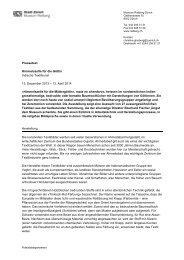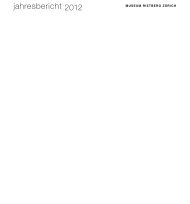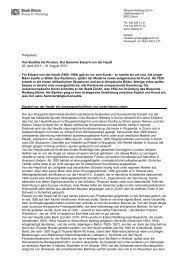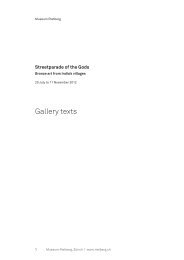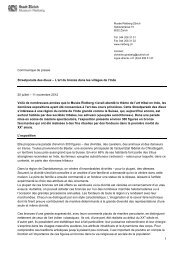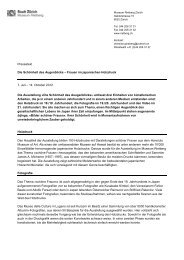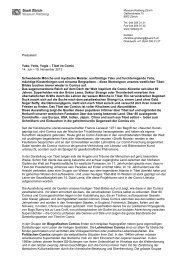1.1 eduard von der heydt - Museum Rietberg
1.1 eduard von der heydt - Museum Rietberg
1.1 eduard von der heydt - Museum Rietberg
Create successful ePaper yourself
Turn your PDF publications into a flip-book with our unique Google optimized e-Paper software.
4.4<br />
erwerbungen<br />
auf dem deutschen<br />
kunstmarkt<br />
zwischen 1933 und<br />
1945<br />
Durch die 1931 eingeführte Devisen-Zwangsbewirtschaftung<br />
gelangte <strong>von</strong> <strong>der</strong> Heydt als Deutscher,<br />
<strong>der</strong> vornehmlich im Ausland lebte, zu einer grossen Menge<br />
nur unter Verlust transferierbarer sogenannter Sperrmark.<br />
Diese setzte er für Kunstankäufe in Deutschland ein. Bedin-<br />
gung war, dass die Kunstwerke fünf Jahre dort verblieben.<br />
Während die Kunst aus Afrika und <strong>der</strong> Südsee nach 1933 in<br />
Deutschland wenig Beachtung fand und kaum gehandelt<br />
wurde, erfreute sich die Kunst Asiens nach wie vor einer<br />
gewissen Nachfrage. Von <strong>der</strong> Heydt kaufte südostasia-<br />
tische Skulpturen sowie chinesische Objekte bei Händlern<br />
und auf Auktionen.<br />
Auf einer Auktion bei Paul Graupe in Berlin erwarb<br />
<strong>von</strong> <strong>der</strong> Heydt im März 1935 fünf chinesische Kunst-<br />
werke. Diese Objekte hatten dem jüdischen Ehepaar Rosa<br />
und Jakob Oppenheimer gehört, die bereits Anfang 1933<br />
Deutschland verlassen hatten. Ihr Eigentum war konfisziert<br />
und für das Finanzamt versteigert worden, das den Erlös einbehalten<br />
hatte.<br />
Ein erstes Resultat <strong>der</strong> Provenienzforschung<br />
am <strong>Museum</strong> <strong>Rietberg</strong> lag 2009 in <strong>der</strong> Aufdeckung dieses Tatbestands.<br />
Da <strong>von</strong> <strong>der</strong> Heydt die Werke auf einer sogenannten<br />
Judenauktion erworben hatte, ist das <strong>Museum</strong> mit den Erben<br />
<strong>der</strong> Familie Oppenheimer in Kontakt getreten, hat die damals<br />
gekauften Objekte entschädigt und ist jetzt <strong>der</strong>en rechtmässiger<br />
Eigentümer.<br />
4.4<br />
acquisitions on<br />
the German art<br />
market between<br />
1933 and 1945<br />
Because of the currency exchange controls<br />
that had been introduced in 1931, <strong>von</strong> <strong>der</strong> Heydt, as a German<br />
who lived mostly abroad, accrued large balances of so-called<br />
“blocked Marks” which could only be taken out of Germany<br />
at a loss. He used these to buy art in Germany. The condition<br />
was that the artworks remain in the country for five years.<br />
Whereas art from Africa and the South Seas received little<br />
attention in Germany after 1933, Asian art still enjoyed a certain<br />
demand. Von <strong>der</strong> Heydt bought South-East Asian sculptures<br />
as well as Chinese objects from dealers and at auctions.<br />
At an auction at Paul Graupe in Berlin in March<br />
1935, <strong>von</strong> <strong>der</strong> Heydt bought five Chinese artworks. These objects<br />
had belonged to the Jewish couple Rosa and Jakob Oppenheimer<br />
who had left Germany in early 1933. Their possessions<br />
had been confiscated and were auctioned on behalf of<br />
the German tax authorities who kept the proceeds.<br />
A first result of provenance research at <strong>Museum</strong><br />
<strong>Rietberg</strong> came with the uncovering of these facts in 2009.<br />
Since <strong>von</strong> <strong>der</strong> Heydt had acquired the works at a so-called<br />
“Jew auction”, the museum contacted the heirs of the Oppenheimer<br />
family, compensated them for the objects bought<br />
at the time and is now their rightful owner.<br />
4.4<br />
acquisitions sur<br />
le marché d’art<br />
allemand entre<br />
1933 et 1945<br />
En tant que citoyen allemand vivant surtout à<br />
l’étranger, Eduard <strong>von</strong> <strong>der</strong> Heydt réussit, grâce à l’introduction<br />
du contrôle des changes en 1931, à acquérir une grande<br />
quantité de «marks bloqués» transférables uniquement à<br />
perte. Il les utilisa pour acquérir des œuvres d’art en Allemagne.<br />
La seule condition était que celles-ci restent dans le<br />
pays durant cinq ans. Depuis 1933, l’art africain ou celui des<br />
mers du Sud n’y suscitait guère l’intérêt du public allemand<br />
et n’était pratiquement pas commercialisé, mais il y avait en<br />
revanche une certaine demande en matière d’art asiatique.<br />
Von <strong>der</strong> Heydt achète alors des sculptures d’Asie du sud-est<br />
ainsi que des objets chinois auprès de marchands d’art ou<br />
lors de ventes aux enchères.<br />
Lors d’une vente organisée chez Paul Graupe<br />
à Berlin en mars 1935, il se porte acquéreur de cinq œuvres<br />
d’art chinois. Ces objets avaient appartenu au couple juif Rosa<br />
et Jakob Oppenheimer, qui avaient déjà quitté l’Allemagne<br />
au début de 1933. Leurs biens leur avaient été confisqués et<br />
avaient été vendus aux enchères au bénéfice de l’Office des<br />
contributions qui avait gardé le montant.<br />
Les recherches concernant la provenance des<br />
œuvres appartenant au Musée <strong>Rietberg</strong> ont permis, en 2009,<br />
de tirer au clair ces faits. Le baron <strong>von</strong> <strong>der</strong> Heydt ayant acquis<br />
ces œuvres lors d’une «enchère de biens juifs», le musée a<br />
décidé de contacter les héritiers de la famille Oppenheimer;<br />
il a, depuis, versé une indemnisation pour les objets achetés<br />
à l’époque et est désormais leur propriétaire légal.<br />
Völkerkundemuseum Berlin, Von-<strong>der</strong>-Heydt-Saal (the Von <strong>der</strong> Heydt gallery /<br />
la salle «Von <strong>der</strong> Heydt»), 1936 (<strong>Museum</strong> <strong>Rietberg</strong> Zürich, Archiv)<br />
Frankfurt am Main, Eröffnung des Chinainstituts (the opening of the China<br />
institute / l’ouverture de l’institut chinois), 1936 (Privatbesitz)






